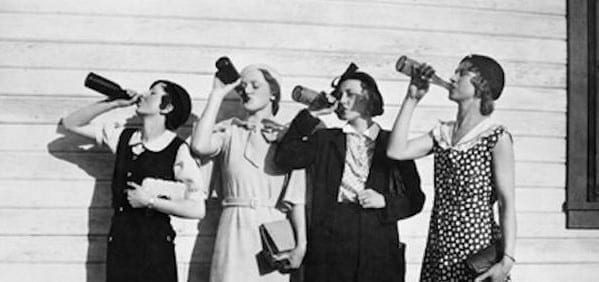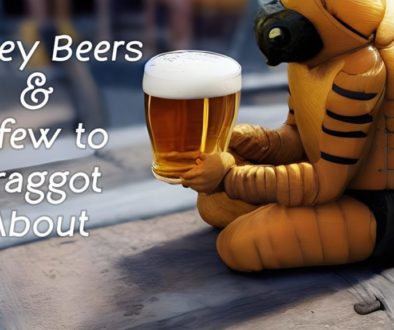…to Make an Informed Decision or, “I’m Going to Drink My Way Down This List Because Whooooooo!”
So, you’ve decided to get high on booze. Congratulations! Let me help you decide what beer style to pick to enjoy your night out on the town, dull the crushing sense of nothingness that consumes you, or purchase a couple bottles for a nice picnic.
Let’s get this out of the way first. There are two distinct categories of beer – [itg-glossary glossary-id=”35528″]Ales[/itg-glossary] and [itg-glossary glossary-id=”35541″]Lagers[/itg-glossary]. They don’t matter. Really. The only difference is the type of yeast used in the brewing process. Lagers use Saccharomyces pastorianus; Ales use Saccharomyces cerevisiae; which type dictates the temperature at which the beer is brewed.
Lager yeast likes cooler temperatures (around 50 degrees Fahrenheit) which causes the yeast to sink to the bottom of the tank during the [itg-glossary glossary-id=”4832″]fermentation[/itg-glossary] process. Ale yeast likes warmer temperatures (around 70 degrees Fahrenheit) which causes the yeast to rise to the top of the tank during the fermentation process. That’s it. I drew a super-scientific diagram on a bar napkin. See:
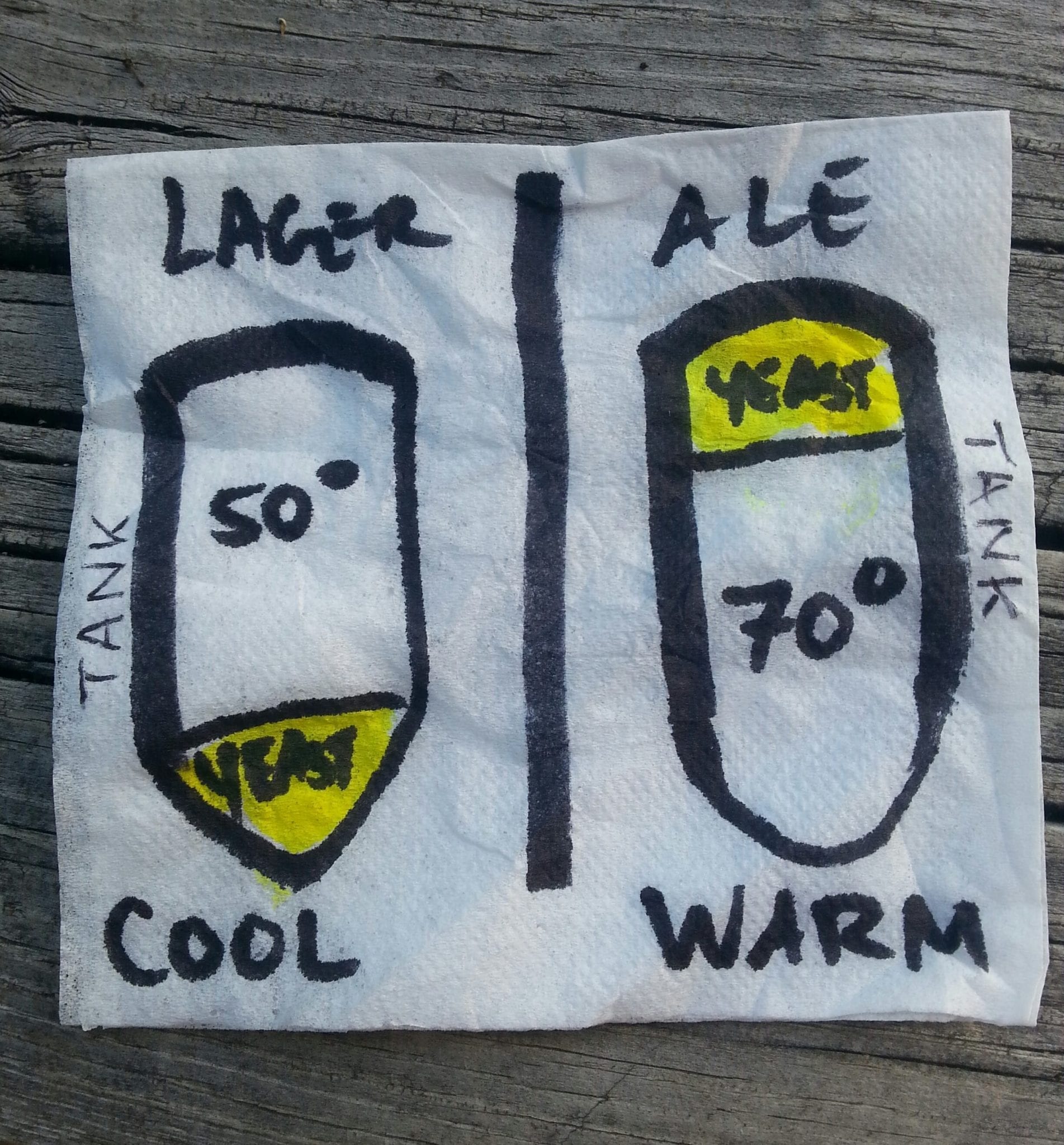
Lagers tend to be “cleaner” and ales tend to be more “flavorful”, but you can have super light ales and dark hoppy lagers. Unless you’re brewing the f—ing beer, you really don’t have to worry about what category it is.
Here are five common types of beer. I’ve grouped together similar styles for the sake of simplicity and due to the fact that I didn’t want to write an endless novicle on the 100+ beer styles almost as much as you don’t want to have to read that.
Contents
Six Common Beer Styles
1. American Lager / Pilsner (Lager)
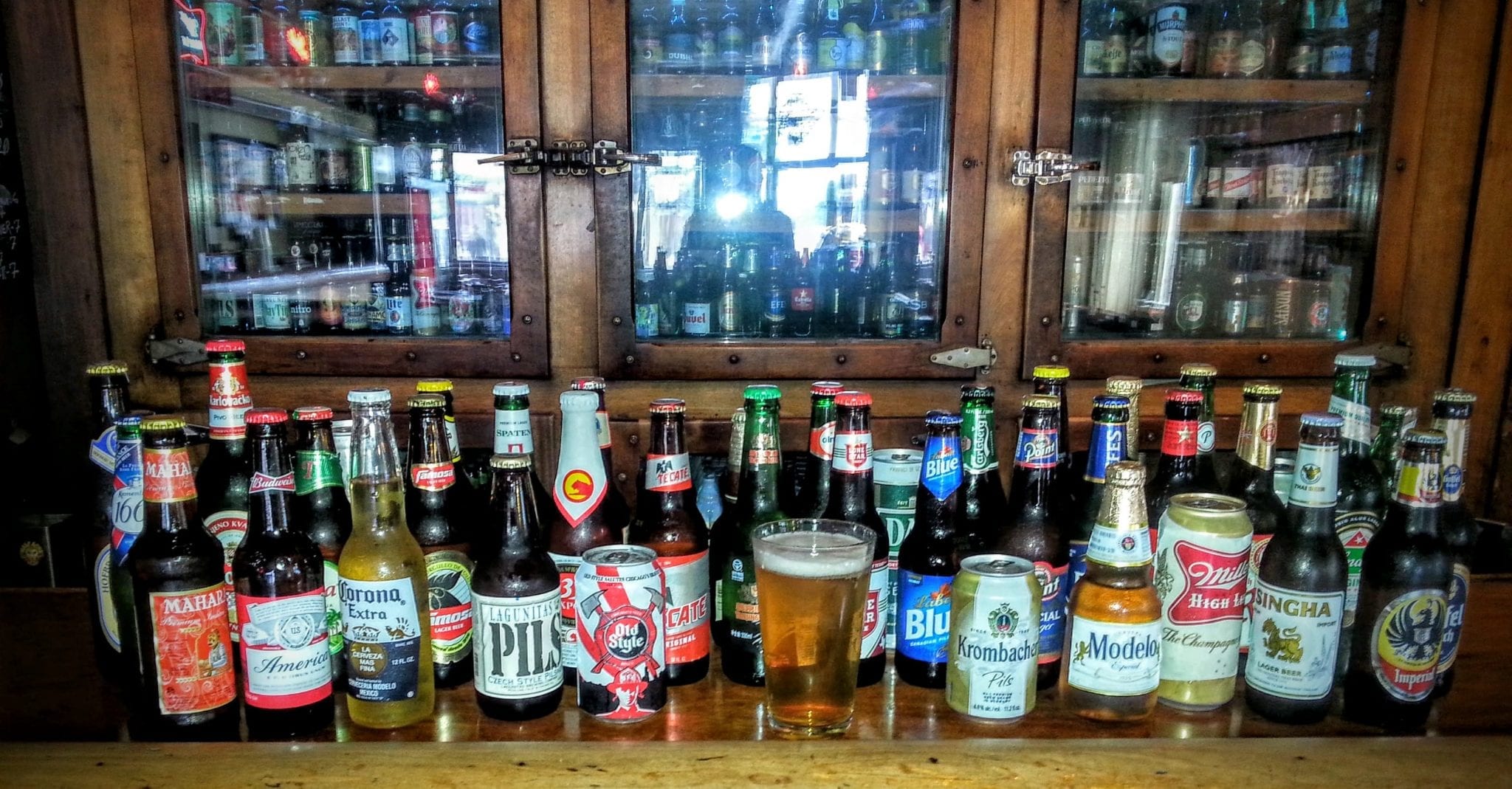
This is what you think of when you think of “beer”. Don’t give me the “Actually, I think of a Finnish Sahti when I think of beer” crap. If that’s is case 1) You’re lying; 2) You’re a pompous ass; or –most likely– 3) You’re lying your pompous ass off.
American Lager was derived from Czech/German Pilsners and this type comprises most of the yellow-fizzy beers from around the world. American Adjunct Lager is far and away the most popular style and has the largest-scale production by a wide margin (FYI: an “adjunct” is an unmalted grain used in the brewing process – …now you know…). Almost any beer produced outside North America or Europe is an American Adjunct Lager (ex: Red Stripe, Tsingtao, Fosters, Tusker…).
As for the Pilsners; German Pilsner tends to be slightly bitter, Czech Pilsner tends to be lighter, and European Pilsner tends to be sweeter.
For all intents and purposes, these beers are interchangeable (but not indistinguishable), along with any of their offshoots (ex: Dortmunder Lager, Kölsch, Japanese Rice Lager…). These are clean, crisp, refreshing beers. Most of these will have a low alcohol-by-volume ([itg-glossary glossary-id=”5644″]ABV[/itg-glossary]) of between 3-5%. If you’re looking for a nice easy refreshing beer that you can drink all day this is what you want.
These styles of beer get a lot of flack for being “crap beers” because most of the crappy beer out there is of these styles – They are the victim of their own success. Clean Lagers/Pilsners are one of the hardest beers to brew well and even harder to do so consistently. There are some exceptional examples of this type.- If this is what you’re looking for, any decent bartender will be able to recommend a good beer of this sort.
Examples of American Lagers
According to vinepair.com the following are the highest selling American Adjunct Lagers:
- Budweiser
- Corona Extra
- Busch
- Modelo Especial
- Miller High Life
- Pabst Blue Ribbon
2. Wheat Beer (Ale)
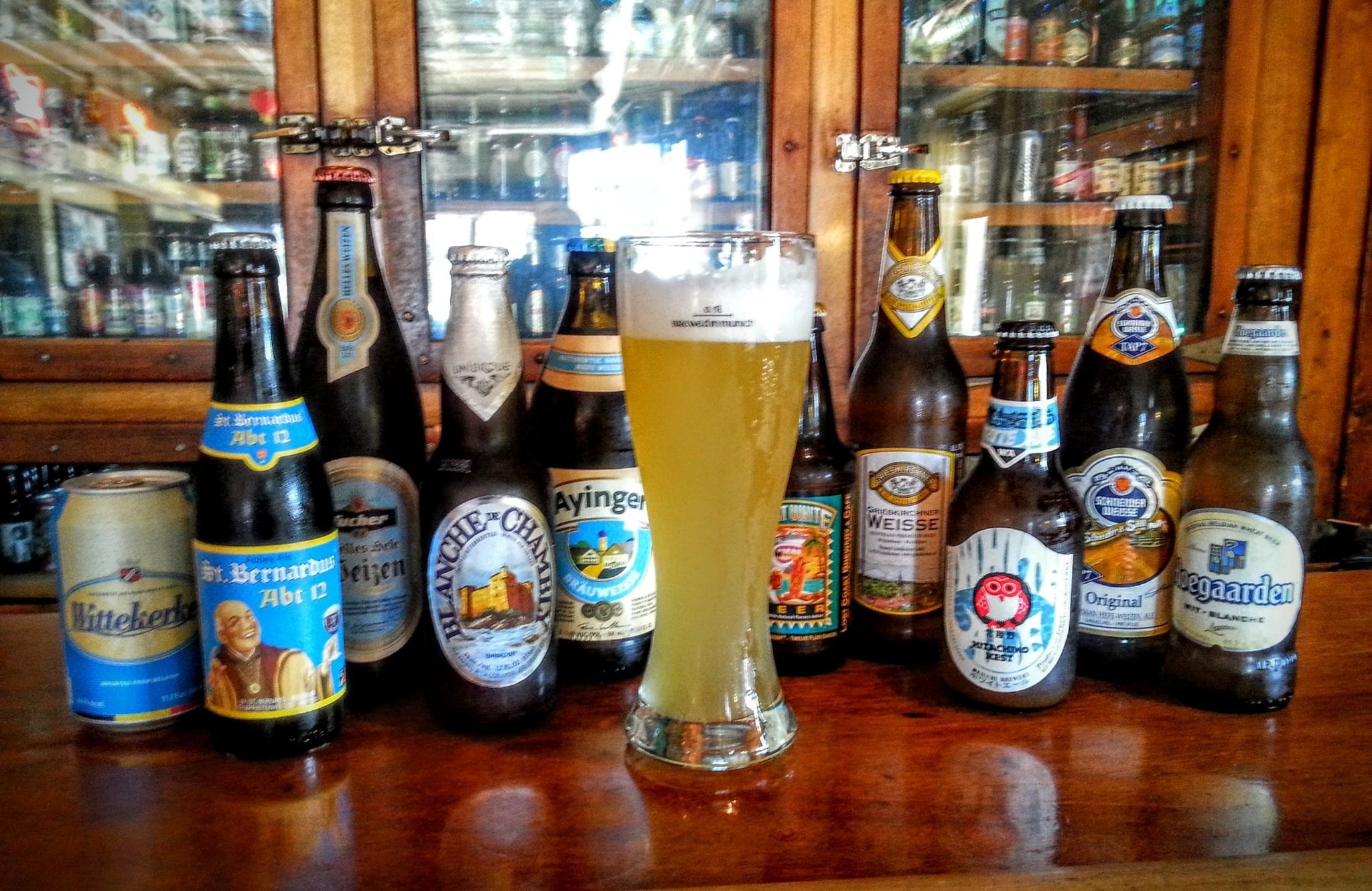
We’re just going to be focusing on Witbier and Weissbier (Weißbier if yer nasty), and save the Berliner Weisse, Lambic, & Gose for the sour article –…wait for it…–. Witbier is Dutch for “White Beer” and Weissbier is German for “White Beer”, so there you are. Anytime you see “white” in a beer name it’s probably going to be a Witbier (except –for instance– Chimay White, which is a Triple, because Belgium).
So what’s a Witbier? Well, everyone knows Blue Moon. Blue Moon is a Witbier …a terrible Wit, but a Wit nonetheless, so let’s start there.
A Witbier is a hazy pale, unfiltered mild ale that uses a herb/spice mixture (called a gruit) to flavor the beer in place of hops. The two common flavoring ingredients in most Wits are coriander and orange (sweet or bitter); they may also include cumin, cardamom, anise, black pepper, or other herbs/spices. It is rare to use hops in the brewing of a Wit, but sometimes a spicy variety such as Saaz could be used.
The taste is a light refreshing flavorful beer that can be imbibed in quantity.
A Weissbier is similar in style to a Wit, but the flavor in the Weiss is derived from specialized yeast strains that impart flavors of banana and clove rather than spicing the beer with gruit.
The oldest continuously operating brewery in the world (Kloster Weihenstephan – 1040AD) produces the prime example of this style. Most Weissbiers made outside of Germany tend to more closely resemble Witbiers than true Weisses (in my experience), so if you want a true Weiss it’s best to stick with the Krautbrau.
Examples of Wheat Beers
According to Paste Magazine, the following are the highest rated Wheat Beers:
- Allagash White
- Urban Chestnut Schnickelfritz
- 3 Floyds Brewing Co. Gumballhead
- Avery White Rascal
- Bell’s Oberon
- Brewery Ommegang Witte
3. Farmhouse Ales

Saisons (pronounced –with a nasal affectation– “say-zone” if you’re that guy – don’t be that guy) are the most popular type of Farmhouse Ales, and the two terms have become completely interchangeable. ‘
I will usually have on 2-3 Saisons on draft at any time and tend to list the earthier beers as “Farmhouse Ales” and the brighter beers as “Saisons” but this is a completely arbitrary distinction. Although Saison is the prevalent style of Farmhouse Ale, not all Farmhouses are Saisons; the Belgian Saison has a sexy French sister style: the Bière de Garde.
Bières de Garde are (essentially) Saisons which are brewed in France, and that seems to be the greatest distinction between the two styles. Bières de Garde tend to be a bit sweeter, and use slightly different yeast strains but that’s about it. For the sake of brevity, all Farmhouses will hereby be referred to as Saisons, because I’m tired of typing and kind of enjoy arguing with pedantic dicks in comment fields.
Saisons are the perfect “middle road” for slightly adventurous beer drinkers. They are more complex than your average Lager, but not as challenging as IPAs or Stouts. The semi-dry style accented with bright fruit notes appeal to wine drinkers and others that usually wouldn’t order beer. Saisons are incredibly popular with the American craft breweries and high-quality examples of the style available year-round despite its origins as a Summer beer.
Replacement Parts has written an EXCELLENT overview of what makes a beer “sessionable”. I highly recommend you check it out.
Examples of Farmhouse Ales/Saisons
According to Paste Magazine, the following are the top rated Saisons:
- Prairie Artisan Ales, “Prairie Ale”
- Brewery Ommegang Hennepin
- Boulevard Brewing Co. Tank 7
- Firestone Walker Opal
- Brooklyn Brewery Sorachi Ace
4. India Pale Ale (IPA) / American Pale Ale (APA)
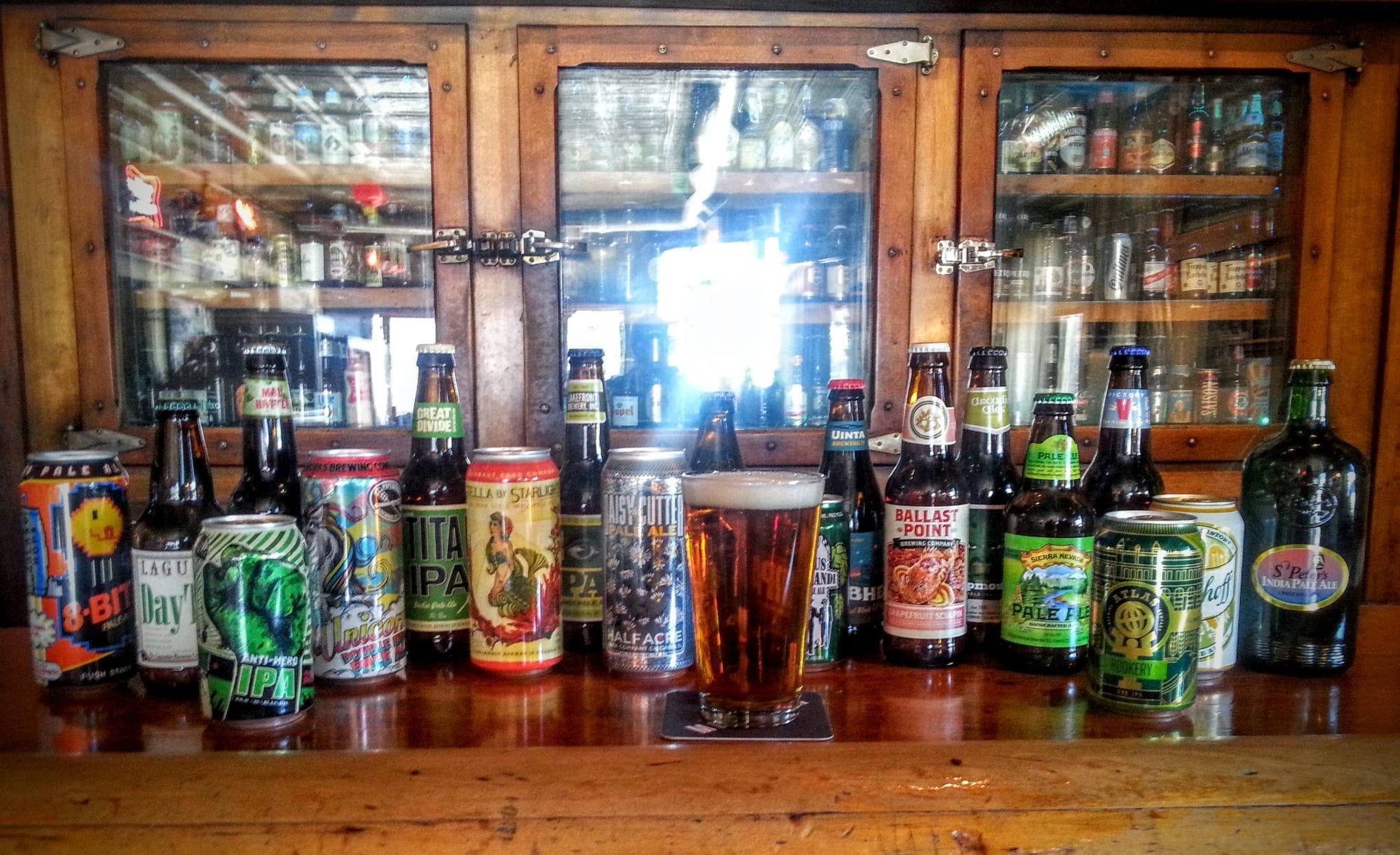
You want a hoppy beer? Here you are. This style more than any other has become synonymous with craft brewing in the United States due to the current wave of breweries reveling in IPAs and APAs. India Pale Ales started off in England as “Pale Export” to be shipped to British troops in India in the 1700s.
These beers were higher in alcohol and strongly hopped to prevent/mask spoilage with the intent that they would be watered-down at the destination to closer resemble a traditional Pale. Once the troops got into the uncut stuff, there was no going back.
American IPAs are much more hoppy than English IPAs and vary greatly amongst the style. American West Coast IPAs tend to be hoppier while East Coast IPAs tend to be more balanced, but there are exceptions galore and regional pockets seem to produce IPA/APAs that are closely related rather than a broader geographic split. There is immense variation in the American IPA style you can go from a light, mellow, low ABV example to a dark, malty, through-the-roof ABV example.
There are no hard rules, but ‘Session” IPAs are low-alcohol and tend to be very light, as opposed to Imperial (or Double/Triple) IPAs which are high-alcohol and tend to be more substantial. Currently, there is a lot of play within the style, such as “Belgian IPAs” (an IPA brewed with a Belgian yeast strain) which are becoming more common.
The line between American IPAs and APAs is vague at best, but APAs tend to have a lower ABV, be less aggressively hopped, and have some amber notes.
Examples of Pale Ales
According to Men’s Journal, the following are the best Pale Ales available in the US:
- 3 Floyds Yum Yum
- Maine Beer Company Peeper Ale
- Sierra Nevada Pale Ale
- Revolution Brewing Fist City
- Ballast Point Grunion
- Half Acre Brewing Daisy Cutter
- New Glarus Moon Man
5. Red / Brown (Lager or Ale)
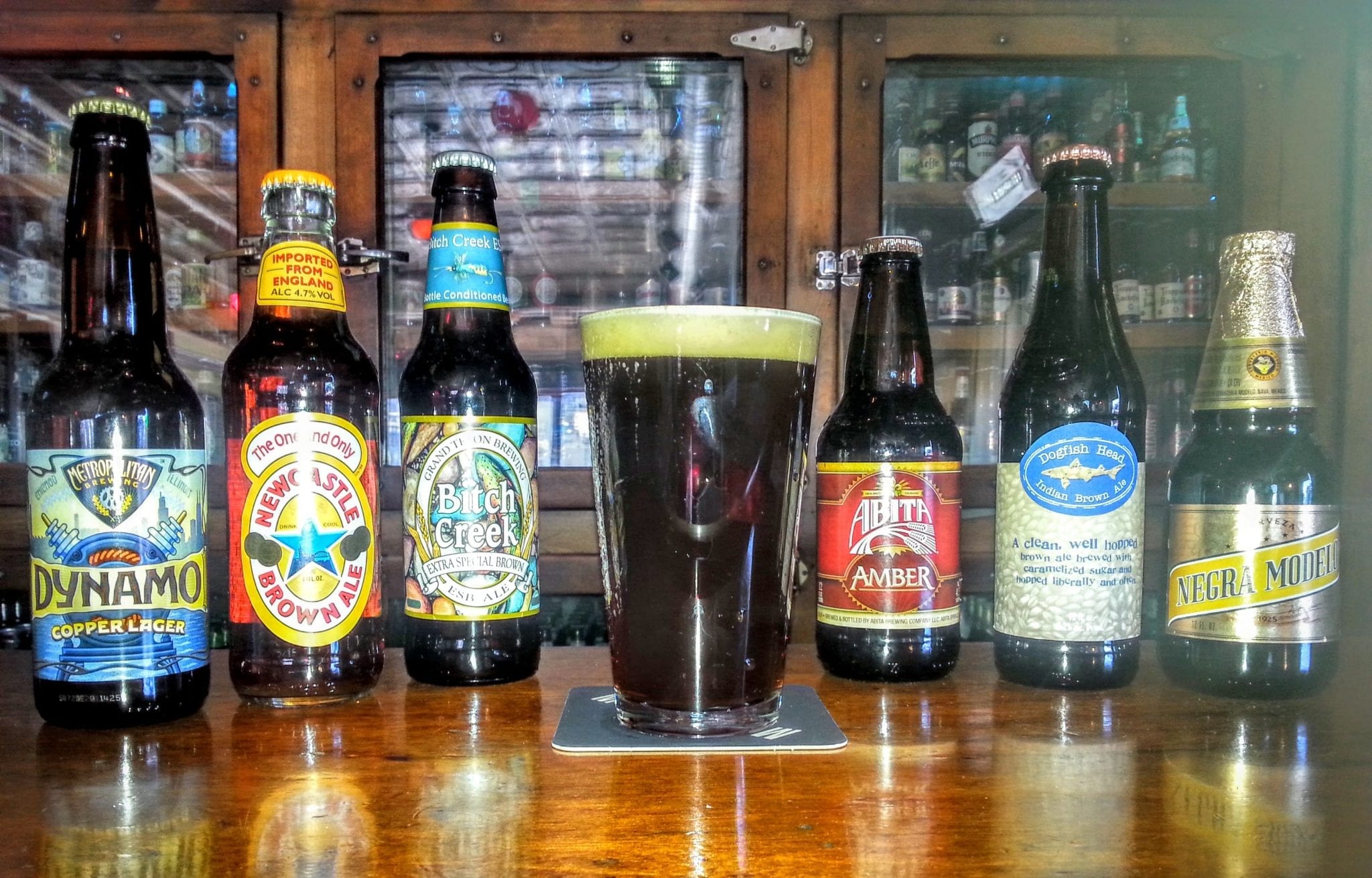 Remember when I said that the whole Lager -vs- Ale thing didn’t matter – Right here. American Ambers can be Ales or Lagers. Bell’s Amber is an Ale, Yuengling Traditional is a Lager, both are American Ambers. Vienna Lagers bridge the two styles and can vary from a light red to a dark brown. Most browns tend to be Ales unless you want to toss Schwartzbiers (Köstritzer) into the conversation like a crazy person.
Remember when I said that the whole Lager -vs- Ale thing didn’t matter – Right here. American Ambers can be Ales or Lagers. Bell’s Amber is an Ale, Yuengling Traditional is a Lager, both are American Ambers. Vienna Lagers bridge the two styles and can vary from a light red to a dark brown. Most browns tend to be Ales unless you want to toss Schwartzbiers (Köstritzer) into the conversation like a crazy person.
Hey kid, you lookin’ for a maltier kinda sweet beer that isn’t as hoppy? Well, I’ve got a beer for you. American Browns harken back to English Browns and American Ambers are our take on Irish Reds. Amber and Brown refer to the color of the beer which (like coffee) gets its depth of color from how long the [itg-glossary glossary-id=”35542″]malt[/itg-glossary] is roasted.
The color of the beer is specified by the Standard Reference Method (“Beer color intensity on a sample free of turbidity and having the spectral characteristics of an average beer is 10 times the absorbance of the beer measured in a 1/2-inch cell with monochromatic light at 430 nanometers.” Which is fancy-talk for “What color is the beer?”). Science!
If you were around for the brewpub boom in the 1990s you’ll remember that EVERY F—ING brewpub had at least one Amber and at least one Brown. You’ll also remember the huge craft beer crash of 1998 probably due to the fact that everyone was only brewing regrettable Browns and Reds. It’s kind of that way with IPAs right now, but that’s totally different, right? Even though Reds and Browns are still far removed from their glory days, it is my understanding that these styles are still fairly popular throughout the rust-belt states and other strange backwaters such as Oregon, Montana, & the United Kingdom.
Examples of Red/Brown/Amber Beers
- Samuel Smith’s Nut Brown Ale
- Leinenkugel’s Classic Amber
- North Coast Red Seal Ale
- Bell’s Amber
- Anchor Brewing’s Brekle’s Brown
- Avery Ellie’s Brown
- Dundee Original Honey Brown Lager
Sources:
Seriouseats.com
Aleheads.com
Totalwine.com
6. Stout / Porter (Lager -Or- Ale)
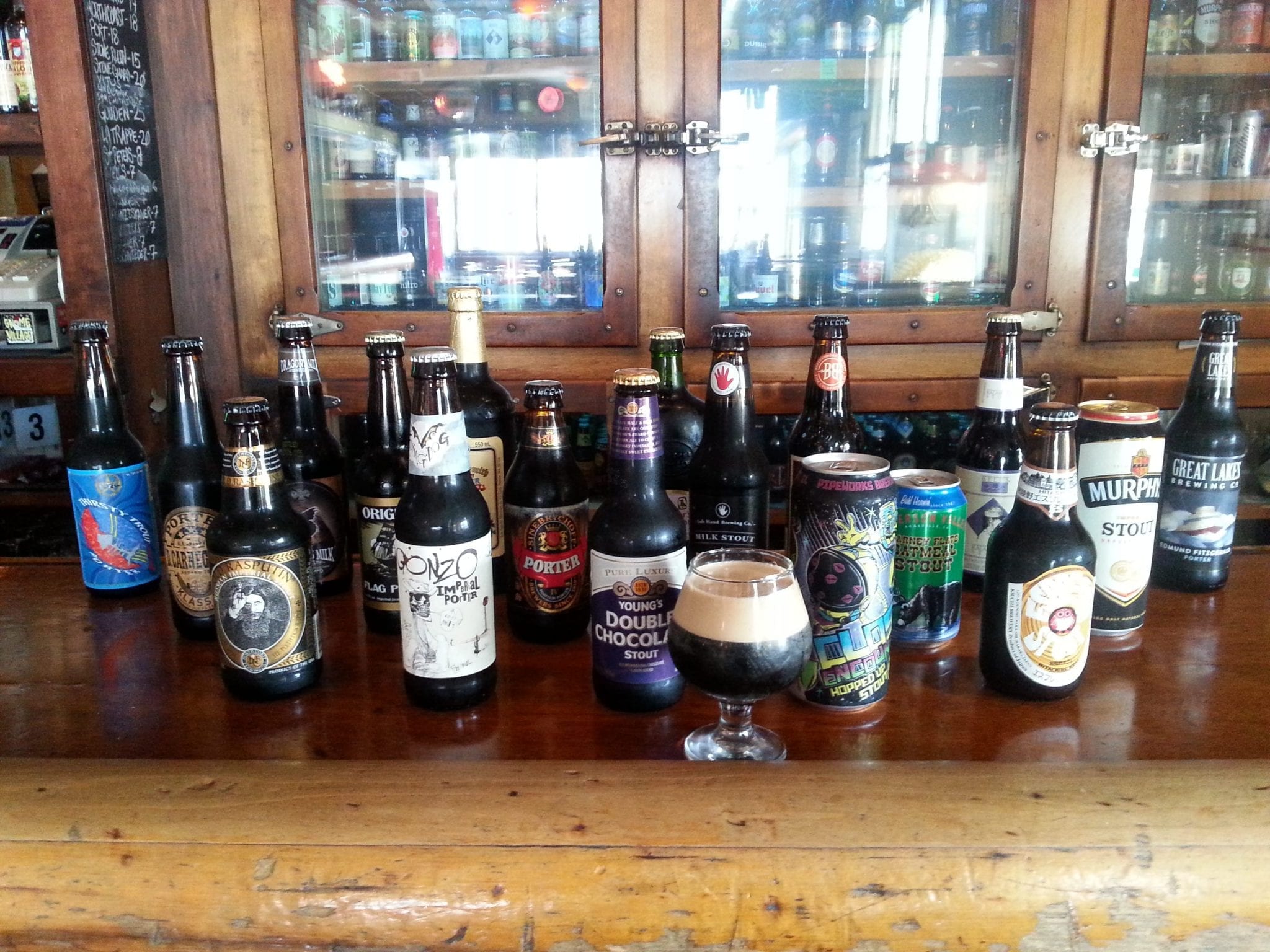
Remember in the last entry when I mentioned how roasting the [itg-glossary glossary-id=”35542″]malt [/itg-glossary]accounted for the depth of color? –providing you didn’t just immediately scroll down here desperately looking for an errant bottle of Bourbon County Stout– Well now we’re in the Espresso of Beers!
Contrary to popular thought, the darkness of the beer has little to do with the alcohol content of the beer, but the darker roast can be used to complement the higher ABV beers exceptionally well.
Irish Stouts come in around 4~5% ABV, whereas it is common for Imperial Stouts to double that at over 10%. Porter is an archaic term for Dark Beer.
Stouts are all Porters, and Porters tend to be lower ABV or blended, but any true difference is nebulous, so from here on out when I mention “Stout” read that as “Stouts and/or Porters”. Thank you for your cooperation.
Stouts are the most dynamic of beer styles. They cellar well, they play well with fruits and spices, you can age them in liquor casks, make them hoppy, make them sweet, blend them with sour ales, keep them as pets, or write turgid erotic fan-fic about them. IT DOESN”T MATTER!
These beers have become so popular that they are now the Beanie Babies of the craft beer world with massive over-hyped release events and Smeagol-level fetishistic hoarding of “rare” bottles by sweaty freaked-out weirdos… myself included.
Examples of Stouts and Porters
- Goose Island Bourbon County Stout
- Hill Farmstead Everett
- Dieu du Ciel! Péché Mortel
- Anchor Brewing Porter
- Two Brothers North-Wind Imperial Stout
- Great Lakes Brewing Edmund Fitzgerald Porter
- North Coast Brewing Co. Old Rasputin Russian Imperial Stout
Sources:
Firstwefeast.com
Yahoo.com
Now You’re An Expert
*takes a deep breath, clears throat, adjusts spectacles*
It is best not to think of the classification of beer as hard science. I like to think of styles of beer as types of dogs because I like beer, I like dogs, and I’m kinda drunk and it makes me giggle (now I really want to do a what breed of dog is what beer style post). There are myriad breeds and mixes, but also great diversity in appearance and personality within a breed. To try and put your foot down and declare “This is a Labrador Retriever, and any dog that has slightly different coloring, shape, or temperament is not!” is both narrow-minded and laughably wrong.
It is just as embarrassingly ridiculous for someone to make the same pronouncement about a Wee Heavy or a Session IPA. Classification is an art and sometimes certain beers don’t neatly fit into any set category. That’s what makes this fun and what makes beer interesting. Uniformity is boring, so expect variety in styles, and if you don’t like one, try another.
Most importantly, have fun – This isn’t stick-up-its-ass wine we’re talking about here.
Welp, I hope I could help in getting you on the road to your crippling struggle with alcoholism. You’re welcome, and I’ll see you passed out at the bus stop.
A big “Thank You” to Quenchers Saloon (2401 N. Western Ave – Chicago) for providing the beer for the photographs. All of the beers pictured (and many more) are available there for you to enjoy.
—
Note: All types and styles of beer are capitalized for the sake of identification.

